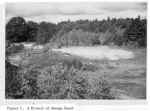|
1978. M.Sc., 131 pp.
BLOWOUTS IN THE SAND DUNES OF WASAGA BEACH
Arbour,
J. H.
 This
thesis is an investigation into the blowouts found in a coastal barrier dune
system at Wasaga Beach, Ontario, Canada. A multidisciplinary approach has been
taken with the aim of describing the characteristics of the process which
produces them. This
thesis is an investigation into the blowouts found in a coastal barrier dune
system at Wasaga Beach, Ontario, Canada. A multidisciplinary approach has been
taken with the aim of describing the characteristics of the process which
produces them.
The Wasaga Beach area was lumbered
heavily during the latter part of the nineteenth century. The exposure of the
dunes that resulted increased the potential for erosion in the dunes. The
shapes, sizes and location of the blowouts indicated that most occur on moderate
to steep slopes and are oriented in a NW/SE direction. Almost two-thirds of the
blowouts are stable or in advanced stages of stabilization. The other one-third
have suffered disturbance due to recreational activities.
Many of the stable blowouts occur in
well treed areas (Pinus resinosa and Pinus strobus dominant). The leaf litter
from these trees is forming an extensive covering on the sand enhancing its
moisture holding capacity, and preventing sand movement. This leaf litter along
with a pioneering moss is an important indicator of blowout stability.
Wind velocity measurements made in
the field indicated a linear relationship between the shape of the blowout and
the velocity change of the wind as it flows through the blowout. The slope of
the surface was used as a shape factor and correlations were determined between
the velocity change and the slope. Measurements in the field yielded correlation
coefficients ranging from r = 0.66 to r = 0.74. Additional measurements
in a wind tunnel using a scale model of the blowout yielded correlations ranging
from r = 0.74 to r = 0.79. A relation between the wind velocity changes
and the slope was inferred from these results. However there are other variables
that affect the wind flow that were not taken into account, such as the amount
of turbulence, the affect of small changes in wind direction and the variability
of wind velocity.
These wind results are used to make
estimations of sand movement rates and patterns in the blowouts. Field
measurements indicate low net rates of sand movement in the blowouts. The
calculations of sand movement based on work done by Bagnold (1941) in flume and
in desert conditions produced higher rates of movement than the measurements
indicated. The temperate climate and vegetative cover of the area can be
attributed with causing this difference.
|